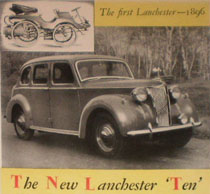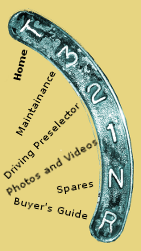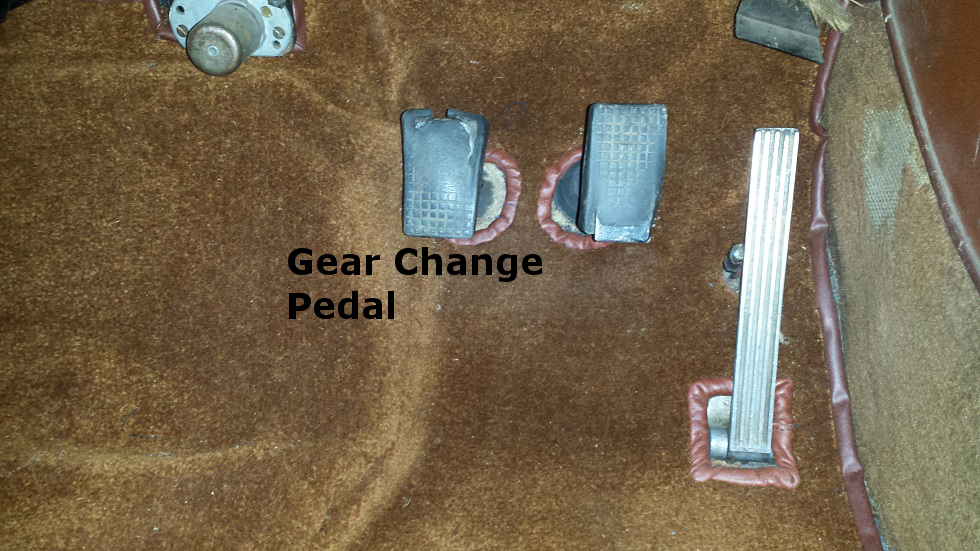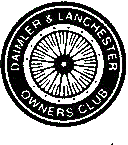

| Driving a Car With a Wilson Pre-Selector Gearbox | ||||||
| In common with many Daimler and Lanchester cars from the mid 20th century, the L. D. 10 is fitted with a semi-automatic Wilson pre-selector gear-change. This offers some advantages over conventional manual and automatic gear change systems. Using a fluid flywheel in place of a clutch means that it is virtually impossible to stall the car, gear changes can be achieved very smoothly and quickly and there is no clutch plate or thrust bearing to wear out. But unlike a fully automatic system, all gears must be selected by the driver so you get all the interactive fun of driving a manual car. | ||||||
| The one fly in the ointment is that people who are used to conventional transmissions can get into difficulties by trying use the floor pedals as they would in their usual car. Bearing in mind the 'torquey' nature of the Lanchester, the results will be anything but smooth and they may dismiss the pre-selector system as awful. | ||||||
 Although the Lanchester has three conventional
looking floor pedals, the one on the left is
not a clutch pedal
but a gear change
pedal roughly analogous to the hand gear lever
found in most cars. To change gear, the pedal
must be pushed quickly in and out which can be
counterintuitive for many new drivers. It should
not be held half way down as
if you were riding a clutch, after all positive
results would not be expected if a conventional gear lever
was held half way between gears. Although the Lanchester has three conventional
looking floor pedals, the one on the left is
not a clutch pedal
but a gear change
pedal roughly analogous to the hand gear lever
found in most cars. To change gear, the pedal
must be pushed quickly in and out which can be
counterintuitive for many new drivers. It should
not be held half way down as
if you were riding a clutch, after all positive
results would not be expected if a conventional gear lever
was held half way between gears. |
||||||
| To
change gear, first you must pre-select it using
the lever on the steering column and then engage
it by pressing the gear change pedal.
For a first time driver, I would suggest engaging top gear with the handbrake on. You will find that the car continues to run quite happily! Then let off the brake and apply a little pressure to the accelerator, the car will creep forward. Repeat with all gears till you get the feel of it. |
||||||
| When
moving up through the gears, the accelerator
should be released just before the gear change
lever is pressed. When changing down, for
example when climbing a hill, the accelerator
should remain depressed. With practice this will
result in very smooth gear changes. If rapid engine braking is required, the accelerator should be released as the gears are changed down. |
||||||
| The recommended speeds for gear changes are shown in the table below | ||||||
| For Maximum Economy | ||||||
|
||||||
| For Maximum Acceleration | ||||||
|
||||||
| Maximum Speed for a given gear (Don't blow your engine!) | ||||||
|
||||||

Click on this logo to go to the
Official L. D. 10 Club Website
 |
 |
 |
 |
 |
 |
“I am an amateur
‘owner
enthusiast’
and have
produced
this
site for
my own
and your
entertainment.
So
please
don’t
expect
100%
accuracy
and seek
professional
advice
before
carrying
out any
work to
your
car. I
think ‘Lanchester’
is
currently
a
registered
trademark
of Tata
Motors.”
Website
produced
using
SharePoint 2007 ©Microsoft, HTML The Missing
Manual and Gimp image editor. Photographs,
videos and site design © Catherine Jones 2015.